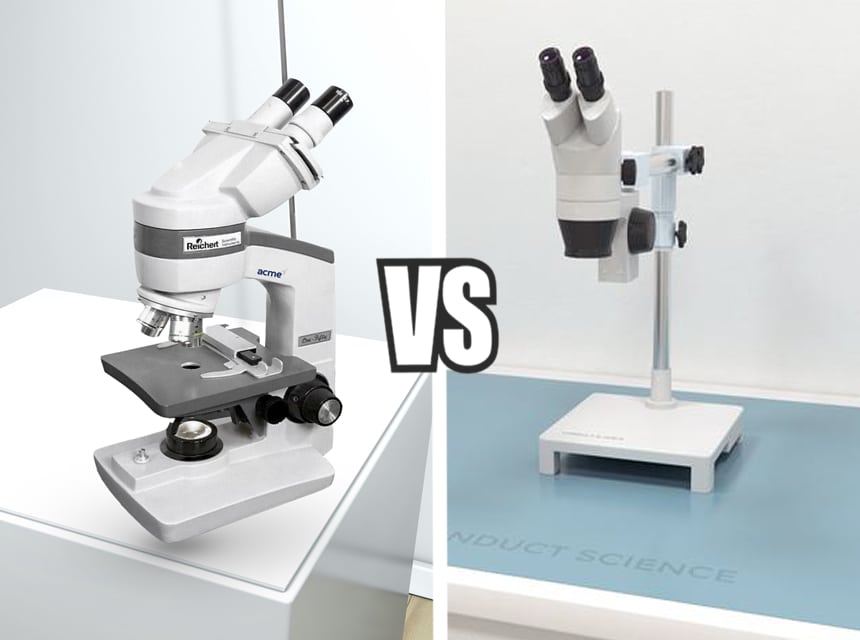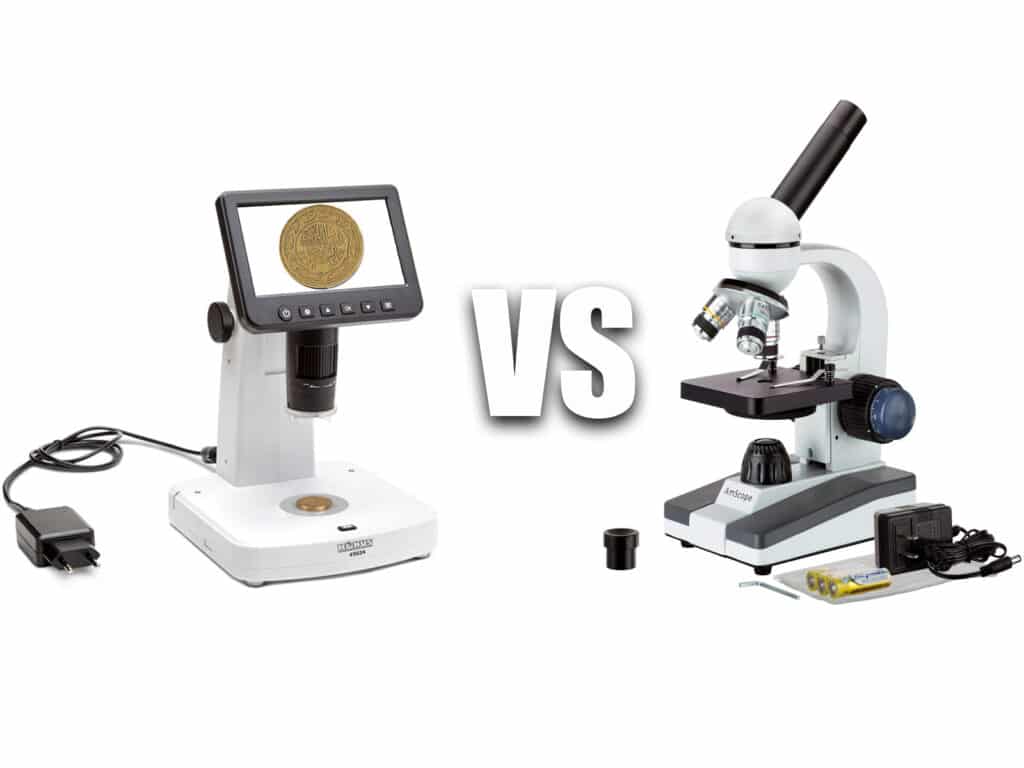

In contrast to a monocular microscope, a stereo microscope creates three-dimensional images. The stereoscopic or dissecting microscopes are instruments that allow the observation of solid, thick, or opaque samples. By using two eyepieces, the images they project are three-dimensional. This type of microscope needs a light source so that you can view objects better. They generally use incident or reflected lighting. Models with adjustable brightness are better for working out contrasts. They are especially useful in close-up works, such as watch-making, working with printed circuits, or studying minerals. So, are you looking for the best stereo microscope for hobby purposes or for your work?
We’ve made a review of the best 4 models by considering aspects like the zoom ratio, magnification capacity, the field of view, working distance, and more. This guide covers all the aspects and characteristics that you must take into account to buy the best stereoscopic microscope. Keep reading and you will discover in the best stereo microscopes reviews and guide the differences between the many models of stereoscopic microscopes. You’ll find out how they work, and what technical specifications you should check before purchasing.
Meiji stereo microscopes of the EMG Zoom Stereo series have the highest zoom range in its line. Just like all other models in the Meiji Techno line, EMG 13 is built with an all-metal aluminum alloy with a chemical-resistant finish. The EMG 13 has a long-lasting life, superior quality and it’s really built like a tank. That’s a reason it comes with a limited lifetime warranty. The EMG 13 body offers a crisp high-resolution precision optics, giving an excellent stereoscopic image.
The MZ 13 zoom range is from 1x to 7x with a ratio of 7 to 1. From its ergonomic position, it has a bilateral zoom control. It’s eye tubes-inclined. At 45 degrees, the EMG 13 provides users a fatigue-free viewing. With its ergonomic eyetube angle, the EMG 13 also has a range of optional eyepieces, auxiliary lenses giving a magnification range from 3 x to 420 x. There are also options for changing your desired working distance. With its dual diopter adjustment, the EMG 13 allows a specimen to be viewed and to remain in focus all throughout the entire zoom range. The interpupillary distance of the EMG 13 also can be adjusted from 54 to 75mm, accommodating different eyetube diameters. And it has a base working distance of 90 millimeters with an optional auxiliary lens. The working distance can be changed from 32mm to 230mm.
What we liked: This is really a perfect model for specimens with minute details in entomology, botany. It can even be used to look at small medical device components due to its high zoom magnification range.
What could be better: There’s nothing to criticize about the stereoscope in terms of material quality and optical performance. However, this model costs an arm and a leg! But if you have the budget, you certainly would fall in love with it.
If you are interested in an advanced stereomicroscope without an exorbitant price, the SWIFT S7 is the model you are looking for. With 7.5x and 45x magnification, this rig is ideal for anything from electronics to mineralogy with a clear and accurate sample display.
In addition to having a wide work area and freedom of movement, the S7 stereo microscope has LED lights so that you do not lose any detail in your observations. It is an ergonomic, adjustable, and easy-to-use device that will not disappoint you and with which you will have a great time.
The 7x to 45x magnification is made possible with the pairing of two 10x widefield eyepieces with a .7x to 4.5x objective lens for zooming. It includes a 56-bulb LED light for an adjustable, bright, and shadow-free illumination. The trinocular stereo microscopes are both powerful and comfortable. It has a head that tilts to 45 degrees, helping the user prevent neck strains. The head can rotate completely at 360 degrees and you can view from any direction or angle. It has a high eyepoint optical system that provides a clear view even for eyeglass wearers.
What we liked: The stereo microscope lets you view solid objects, which include circuits boards, gems, and coins.
What could be better: The stereo microscope is only ideal for viewing solid objects. Its magnification which is limited to 45x is not great for viewing minute or micro-objects like bacteria or small insects.
The cheapest high-quality stereo microscope you’ll ever find on the market, the Levenhuk LabZZ M4 provides a three-dimensional image. It is perfect for studying large minerals, soil samples, coins, stones, plants, and insects. This model is specially designed for children. The microscope is small, lightweight, and easy to operate. With its help, a young biologist will be able to conduct real scientific experiments at home and study the world around him.
The microscope has a comfortable binocular attachment and a lens with a fixed 2x magnification. The kit includes two wide-angle eyepieces with a magnification of 20x. The large field of view of the microscope allows you to examine extended objects. The magnification of 40 times allows you to study in detail the structures of objects.
For research, samples are placed on a round stage, micro slides can be secured with metal clamps. In low light conditions, the top LED backlight is used. It runs on batteries (although not included).
With the Levenhuk LabZZ M4 microscope, your child will be able to make many interesting new discoveries. All optics are made of high-quality glass, which means that it will not harm your eyes at all. The binocular allows you to look at samples with both eyes at once. This makes the research process more comfortable and provides a complete view in detail.
What we liked: We like its operating temperature range of 0 to 40 degrees. This means that you can take the microscope on travel and use it outdoors in summer. For convenient storage and transportation, a case is supplied in the kit. In the evening and at night, LED illumination, which runs on two AA batteries, comes in handy. Lastly, for its quality, the price is a steal as it can buy at least 45 Meiji Techno EMZ-13s.
What could be better: Like the SWIFT S7 7X-45X, the magnification is low.
The use of a stereomicroscope is no longer limited only to biology, geology, and electronics. The microscope is also used in medicine, dentistry, veterinary medicine, mineralogy, in the semiconductor industry, radio installation, and restoration work, as well as in other fields of science and technology. Moreover, now the stereomicroscope should be able to document for later image analysis or discussion.
Using the most common type of Infinity (CMO) objective, the Motic K series of stereomicroscopes provide and display distortion-free 3D images. The combination of CMO and calculation for “infinity” reduces fatigue during prolonged work. The purity of the optical system of the CMO lies in the use of two parallel light beams passing through one objective.
One of the stereo binocular microscopes of the K series of Motic laboratory uses a parfocal system that minimizes the time between setup and observation. With Infinity optics and 4-stage magnification changeover, it is adjustable from 6x to 12x, 25x and 50x. The magnifications are used with 1x objective and 10x / 23mm wide-field eyepieces. It has a base for working with incident light.
What we liked: The microscope allows the mounting of a digital camera. It is perfect for college and university students. You can use it for dissection, quality control, and inspection.
What could be better: There’s really nothing to complain about. It’s the best stereo unit among the Motic stereo microscopes. It’s not expensive, neither is it cheap.
Buying a stereo microscope gives you access to 3-dimensional observations not found in compound microscopes. In this section, we will explain to the letter, details about this device and how to buy the best.
Stereomicroscopes have two separate optical channels for viewing the sample with separate objective and ocular lenses. The stereomicroscopes provide a lower magnification than the compound microscopes. The magnification of stereomicroscopes is usually between 5x and 80x. The images seen are usually in three dimensions and not flat. It’s used in the mud logging industry; by botanists to study plants; for tissue and textile analysis; by pathologists for dermatological examinations or anyone who works with small objects.
As with your real eyes, these two divided viewing angles produce a three-dimensional image. This makes it ideal for observing or examining the surfaces of solid materials. These units can be used to work with clocks, circuits, and also in microsurgery.
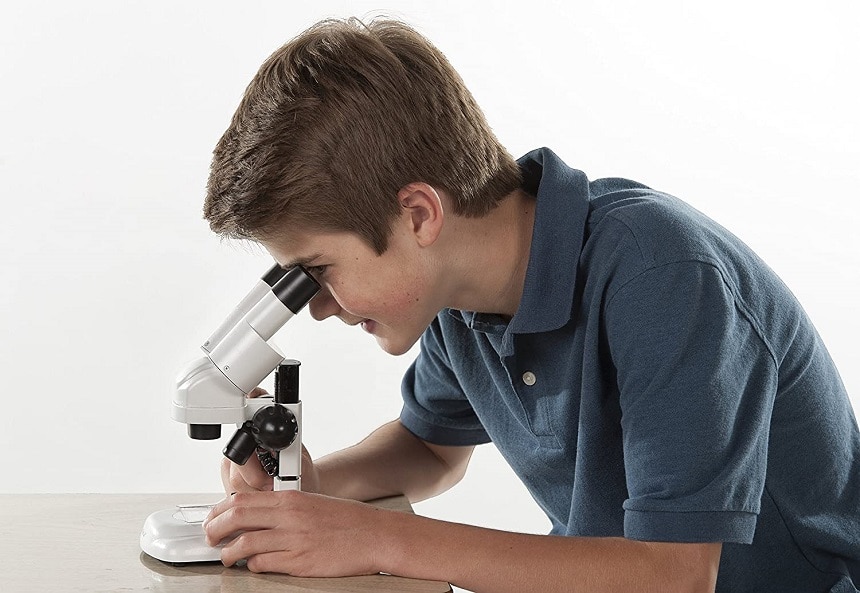
This type of microscope works at low magnification. It uses two separate optical paths to operate, rather than one path. The two lenses and the two eyepieces give the eyes a little bit different viewing angles. Therefore, the left and right eyes look at the same object but differently.
This type of microscope works at low magnification. It uses two separate optical channels to operate, instead of a single channel.
As with your real eyes, these two divided viewing angles produce a three-dimensional image. This makes it ideal for observing or examining the surfaces of solid materials. These units can be used to work with clocks, circuits, and also in microsurgery. This feature made it possible to maintain the stereomicroscope as a mainstay in the microscopic world.
To choose the best stereoscopic microscope, you have to take into account a series of features. Below, you will find some tips and information so that you can make an informed decision.
A basic distinction is made between numerous types of microscopes. These include, for example, light microscopes and electron microscopes. You can find out exactly what makes up each variant in the following table.
| Type | Properties |
| Light microscope | · Illumination is from below
· Available as monocular and binocular microscopes · available with and without built-in photosensor · also available as a digital microscope with USB |
| Reflected light microscope | · Illumination is from above
· Differentiation between inverse and upright models · for viewing opaque objects |
| Electron microscope | · Works with electron beams
· Very good resolution · Objects can be microscoped up to a minimum length of 0.1 nanometers |
Users who need working at the same magnification actually don’t need a large zoom ratio or range. However, you may need to have a larger zoom range if you need to search, find, and manipulate samples. This helps you to be able to switch from low to high magnifications.
The typical magnification range for stereomicroscopes is 9x to 20x. You may have up to 70x or 80x for the most powerful, such as the Meiji Techno EMZ-13. Knowing this, ask yourself what do you plan to observe? Do you need a stereomicroscope for welding? With this range of magnification, if what you want to see are bacteria or cells, these microscopes are not going to help you. This is because microorganisms require magnifications of 500x to 1000x to be properly observed. Therefore, the magnifications offered by stereomicroscopes are suitable for viewing larger samples like coins, so you can zoom in and see details better.
The field of view for eyepieces of optical microscopy is the diameter of the object field multiplied by the magnification of the objective used in mm. With better eyepieces, it is often engraved next to the indication of the magnification. For eyepieces in which a real image is created in front of the first lens, there is the field stop with this diameter.
At 40x of magnification, you can see 5mm. At 400x of magnification, you can see 450 microns or 0.45 mm. With a field of view of 20 mm and a 40-fold magnifying objective, the result is an object field diameter of 0.5 mm and an area of 0.196 mm . If there are intermediate enlargements in the beam path (e.g. with a 1.5x lens), the calculation must be adjusted accordingly.
Stereomicroscopes are optical devices with two objectives. Each of these connects to each eyepiece. These objective lenses and the eyepieces are both responsible for the microscope’s magnification. They can also have a single fixed lens, a rotating multi-lens turret, or a zoom that allows you to change the magnification levels depending on the applications.
Sometimes, there are stereomicroscopes that offer little room to maneuver the sample. While there are others that have a movable arm that give much more freedom of movement. Whatever your case, you will have to ask yourself what you want it for. Then, relate your purpose to the working distance and field of view of the microscope. In any case, there are many models to choose from. So you will have to consider getting a shorter or longer working distance or a larger or smaller field of view depending on what you want to observe.
If you want a device with a shorter working distance not more than 75mm, choose the Levenhuk LabZZ M4. And if you want a long working distance of up to 230mm, select the Meiji Techno EMZ-13. But keep in mind that the longer the working distance, the more you pay.
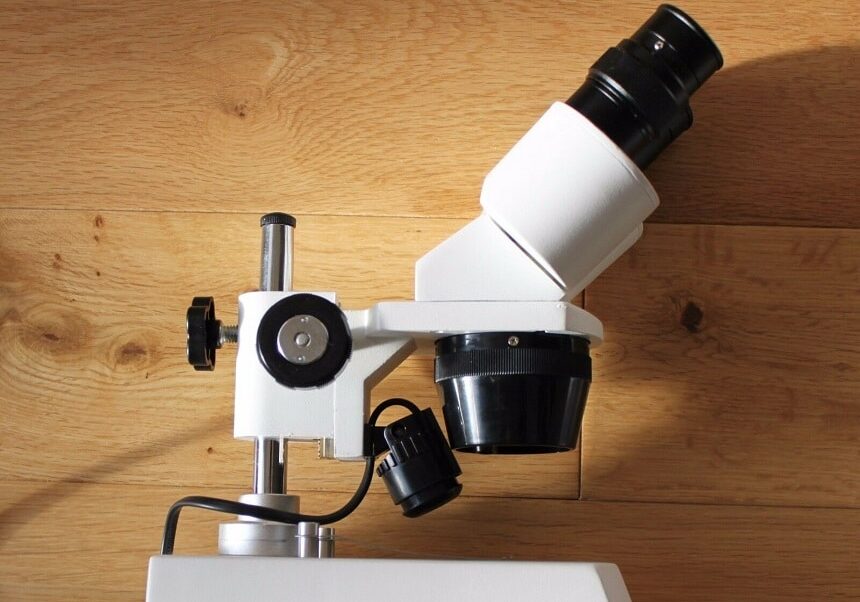
Lighting influences the recordings. With light microscopes, the type of lighting is very important. During the work, objects to be examined are illuminated from above. Another variant is the transmitted light illumination in the stand base. With this, you can often work with light from above and below at the same time.
Halogen lamps are usually used. But long-lasting LED lamps are also installed. However, the light looks very artificial, which can affect the recordings. On the other hand, LEDs have the advantage that they save electricity and, thus, costs.
Basically, you should choose the optimal light depending on the application. What magnifications do you want to work with? Which objects should be examined? For example, if you want to examine light-absorbing objects like black rubber, more brightness is required. At low magnifications, spotlighting or ring light are suitable as a light source. Small magnifications are magnifications between 5x and 35x. At high magnifications of over 35x, you won’t get very far with the direct light sources. The increasing magnification demands more brightness, which is why external light sources are bundled into a small section using fiber optics.
In this section, we have to say that the vast majority of stereoscopic microscopes do not have cameras to capture images. So if you want to take photos of your observations you will have to buy a separate camera or some support to place the mobile. What you will find in stereo devices are models with a third eyepiece prepared for the installation of a camera. For example, Motic K-401P supports the use of digital cameras.
Almost everything is digitized these days. Digitization is therefore also taking effect with microscopes. For this, it is important that the stereo microscope is equipped with a camera. The corresponding images can be recorded with the camera.
Using a USB connection, you can easily transfer images to the PC – i.e. connect the PC to the microscope – and view the image on the screen.
Metal bodies and glass optics are undoubtedly the best materials with which a microscope can be made compared to any plastic part. But as you can imagine, these materials increase the price of the microscope, which makes you to, in many cases, opt for more affordable plastic models. If that’s the case, take your time to see the best stereomicroscope reviews and read other users’ reviews to see what to expect from each product. If the body is made of plastic, you will have to protect it in some way. You’ll even avoid leaving it on the table so that the sunlight does not damage it.
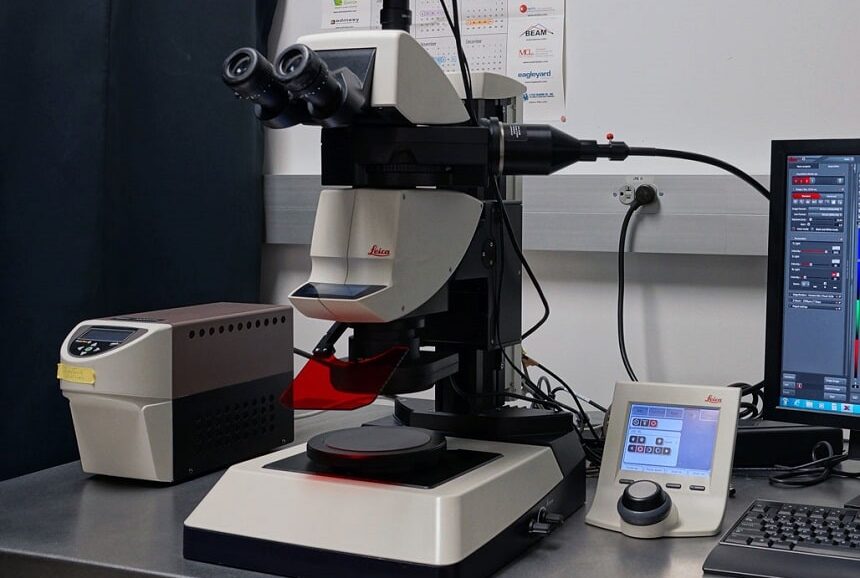
A few models come with a lifetime warranty (whether limited or not), such as the Levenhuk LabZZ M4 and the Meiji Techno EMZ-13, which is great. Stereo microscopes are usually expensive, so you should always choose the best warranty coverage as much as possible. In the minimum, 5 years covering the mechanical parts, such as the Motic K-401P offers, is still acceptable
The cost of a microscope can vary depending on its type, its size, the technology it has integrated, and the manufacturing materials used. A simple stereo binocular microscope that children can use to see plants, stones, and various objects, can cost between 20 and 60 dollars. On the other hand, a stereo microscope with more than 200mm working distance and inclined eye tube can cost thousands of dollars. An example of this is the Meiji Techno EMZ-13.
Our overall best and the Editor’s Choice is the Meiji Techno EMZ-13. This premium-quality stereo microscope is built with an all-metal aluminum alloy with a chemical-resistant finish. It has a long-lasting life, superior quality and it’s really built like a tank. It comes with a limited lifetime warranty.
The runner-up is the SWIFT S7 7X-45X. This trinocular microscope is both powerful and comfortable. It has a head that tilts to 45 degrees, helping the user prevent neck strains. The head can rotate completely at 360 degrees and you can view from any direction or angle. It, thus, is our Best Value model.
Finally, you can choose our Budget Pick, the Levenhuk LabZZ M4, if you want the best stereo microscope that comes at an under 100 price. The cheapest high-quality stereo microscope you’ll ever find on the market, the Levenhuk LabZZ M4 provides a three-dimensional image. It is perfect for studying large minerals, stones, coins, soil samples, plants, and insects. This model is specially designed for children. The microscope is small, lightweight, and easy to operate.
We hope that our list of the best stereo microscopes and the tips on how to pick the suitable model will be helpful when you’re going o omake your choice!


